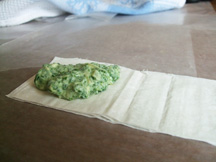Every two weeks, I grab a handful of plastic bags from the cupboard and stroll a few blocks over to my CSA pick-up spot. Immediately upon arrival I survey the bounty of vegetables I’m about to receive. The best weeks offer a large variety: perhaps a few zucchini, a head of lettuce, maybe some tomatoes, corn, string beans, or peppers. Usually I can barely contain my excitement as I start to fill my bags with produce, eagerly looking forward to the dishes I will cook that week.
But this year’s unpredictable weather has lead to an abundance of greens from my CSA. Arugula, spinach, bok choy, lettuce, kale, chard, you name it. Now, don’t get me wrong, I have nothing against leafy vegetables. But receiving multiple bags of greens at once, all of which need to be eaten quickly before they wilt, presents a daunting challenge, especially when you hate wasting food like I do.
Last Saturday’s pick-up was one of those oh-my-goodness-how-will-I-finish-these-greens moments. When I arrived home and examined my haul on the kitchen table, I was faced with overflowing bags of bok choy, arugula, and chard, not to mention a huge head of romaine lettuce. How on earth were Jim and I going to eat all of these greens before they spoiled in a few days?

1. Bok Choy, Brussels Sprouts, and Shrimp Stir-Fry
We didn’t waste any time. On Saturday night we whipped up a quick stir-fry using the bok choy, some week-old brussels sprouts leaves from the farmers’ market, and shrimp. Jim created a light sauce using sesame oil, rice vinegar, and soy sauce, and we also seasoned the dish with fresh garlic and ginger. The slightly sweet sauce perfectly complemented both the meaty shrimp and the crisp, healthy greens. For a very off-the-cuff sort of meal, we were pleasantly surprised by its success.




2. Arugula Spanakopita
When I took my massive bunch of arugula out of the fridge on Sunday, it was already starting to wilt. Fortunately we had already planned to use these peppery greens in some spanakopita appetizers for the Sunday football games. In our version of this Greek snack, we replaced its traditional spinach-based filling with arugula. After some slicing and folding of filo dough, these bite-size, flaky triangles of ricotta, feta, and chopped arugula were quickly assembled on Sunday morning, and devoured just as quickly a few hours later.

3. Italian-Style Swiss Chard
As a finale to our weekend of greens, on Sunday night after the football games I blanched and sautéed the swiss chard as a side dish to some lovely braised short ribs my sister and her husband prepared for us. Lightly dressed with olive oil and lemon juice, the chard was a fresh, simple side dish to accompany the rich beef ribs.
So that was our weekend marathon of greens. I think we did a pretty admirable job with them, don’t you? We’re still working our way through that head of romaine lettuce, eating salads as quickly as we can. I’m optimistic that we’ll make it to the finish line without wasting any food, just in time for our next CSA challenge.








 Subscribe to the Choke
Subscribe to the Choke 
